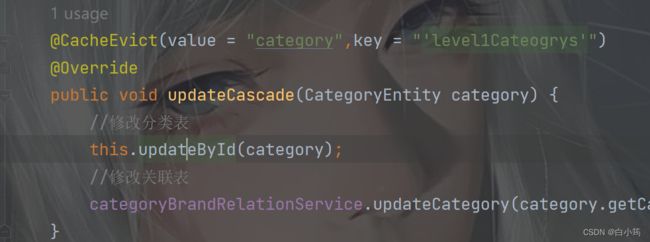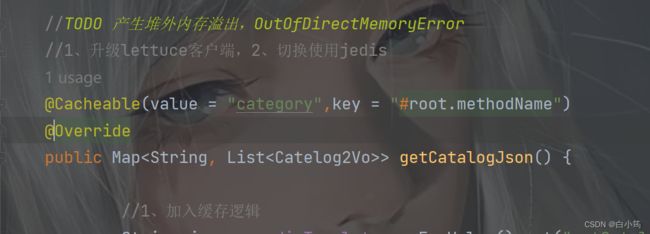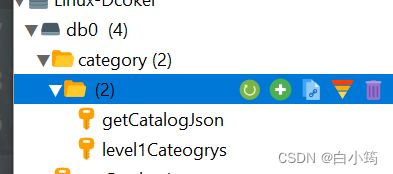整合SpringCache
整合SpringCache
1、引入依赖cache还有redis
org.springframework.boot
spring-boot-starter-cache
2、写配置
spring:
cache:
type: redis
3、测试使用缓存
@Cacheable:触发将数据保存到缓存的操作
@CacheEvict:触发将数据从缓存中删除的操作
@CachePut:不影响方法更新缓存
@Caching:组合以上多个操作
@CacheConfig:在类级别共享缓存的相同配置
1.开启缓存注解@EnableCaching
//指定缓存的名字
@Cacheable({"category"}) //代表当前的方法是需要缓存的,如果缓存中有,方法不调用,如果缓存中没有,则调用方法,最后将方法的结果放入缓存
默认行为:
key是默认自动生成的
缓存的value的值,默认使用jdk序列化机制,将序列化后的数据存到redis中
默认ttl时间-1
自定义操作:
1、指定key:key属性指定,接受一个
2、指定缓存的存活时间
3、将数据保存为json
spring:
cache:
type: redis
redis:
time-to-live: 60000 #毫秒
@Cacheable(value = {"category"},key = "'level1Cateogrys'")
修改保存为json格式
创建配置类
@EnableConfigurationProperties(CacheProperties.class)
@Configuration
@EnableCaching
public class MyCacheConfig {
@Autowired
CacheProperties cacheProperties;
@Bean
RedisCacheConfiguration redisCacheConfiguration(){
RedisCacheConfiguration config = RedisCacheConfiguration.defaultCacheConfig();
//key的序列化机制
config.serializeKeysWith(RedisSerializationContext.SerializationPair.fromSerializer(new StringRedisSerializer()));
//Value的序列化机制
config.serializeValuesWith(RedisSerializationContext.SerializationPair.fromSerializer(new GenericJackson2JsonRedisSerializer()));
CacheProperties.Redis redisProperties = cacheProperties.getRedis();
//将配置文件中的所有配置都生效
if (redisProperties.getTimeToLive() != null) {
config = config.entryTtl(redisProperties.getTimeToLive());
}
if (redisProperties.getKeyPrefix()!=null){
config=config.prefixCacheNameWith(redisProperties.getKeyPrefix());
}
if (!redisProperties.isCacheNullValues()){
config=config.disableCachingNullValues();
}
if (!redisProperties.isUseKeyPrefix()){
config=config.disableKeyPrefix();
}
return config;
}
}
其他的配置
spring:
cache:
type: redis
redis:
time-to-live: 60000 #毫秒
key-prefix: CACHE_ #前缀
cache-null-values: true #是否缓存空值----能够防止缓存穿透
@CaheEvict的使用
这里的key注意里面是单引号
@CacheEvict(value = "category",key = "'level1Cateogrys'")
当修改三级分类后缓存会被自动删除
@Cacheable(value = "category",key = "#root.methodName")
访问gulimall.com首页
当修改菜单后,如何将上面这两个缓存同时删除
在更新菜单的方法上实现
使用@Caching注解实现
@Caching(evict = {
@CacheEvict(value = "category",key = "'level1Cateogrys'"),
@CacheEvict(value = "category",key = "'getCatalogJson'")
})
还可以使用
@CacheEvict(value = "category",allEntries = true)
删除category分区下的所有缓存
如果下面这种方式,产生的缓存就会按照下面的图片一样展示
@CacheEvict(value = "category",allEntries = true)
Spring-Cache的不足
1、读模式:
缓存穿透:查询一个null数据。解决:缓存空数据
缓存击穿:大量并发进来同时查到一个正好过期的数据 。解决:默认无锁;sync=true(加锁)
缓存雪崩:大量key同时过期。解决:加随机时间。加上过期时间
2、写模式(缓存与数据库一致)
读写加锁
引入Canal、感知到Mysql的更新去更新数据库
读多写多,直接去数据库查询就行
总结:常规数据(读多写少,即时性,一致性要求不高的数据,完全可以使用Spring-Cache)



